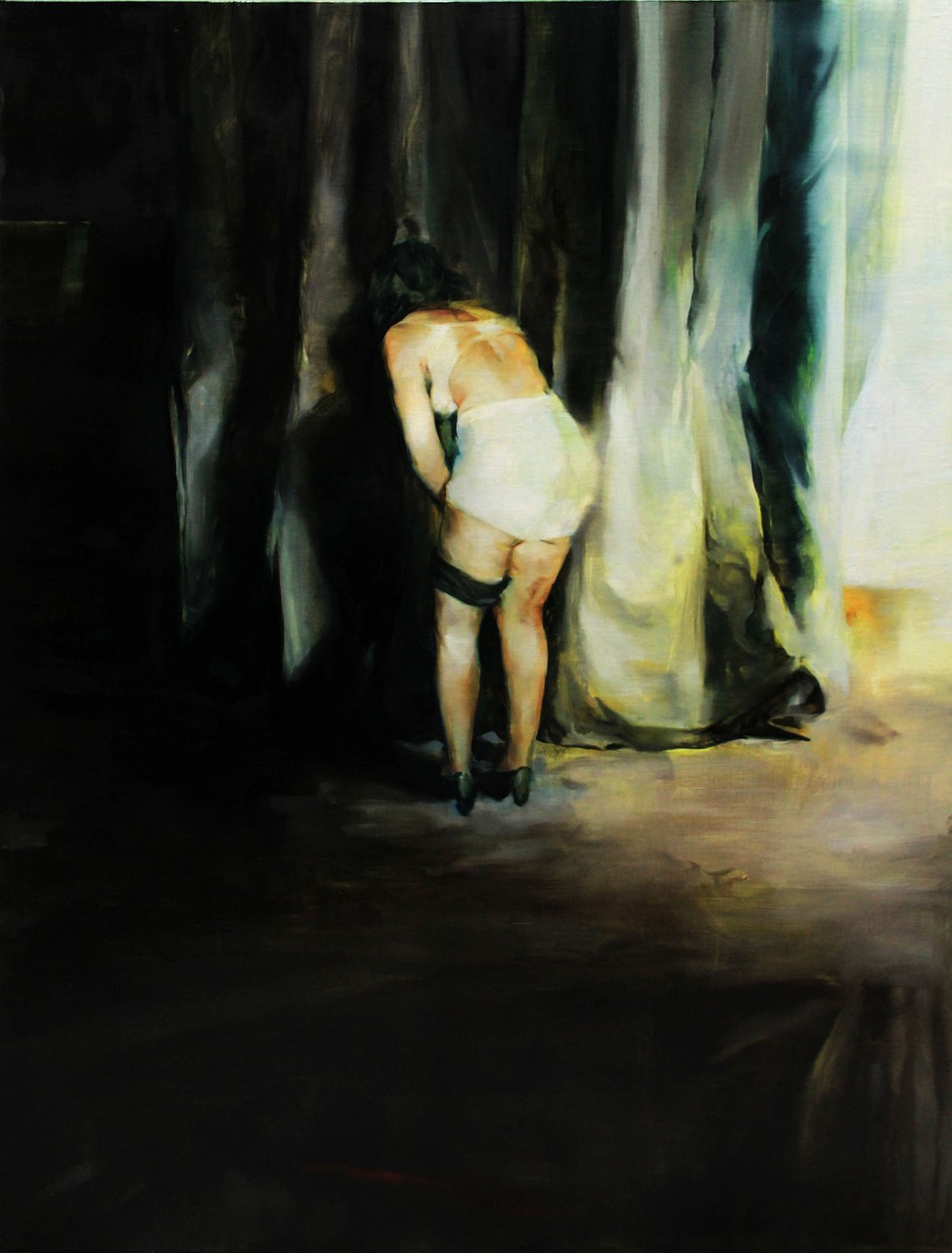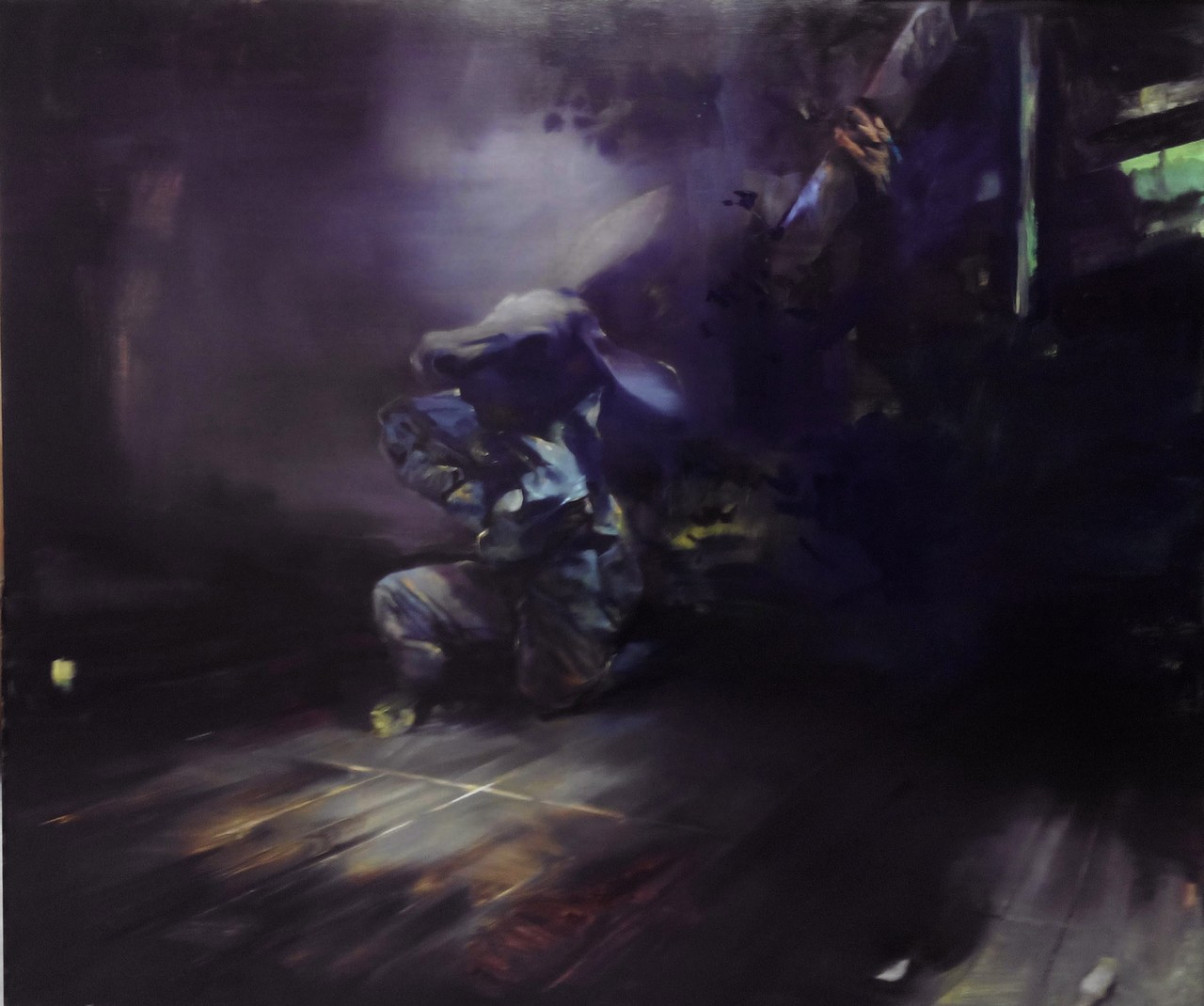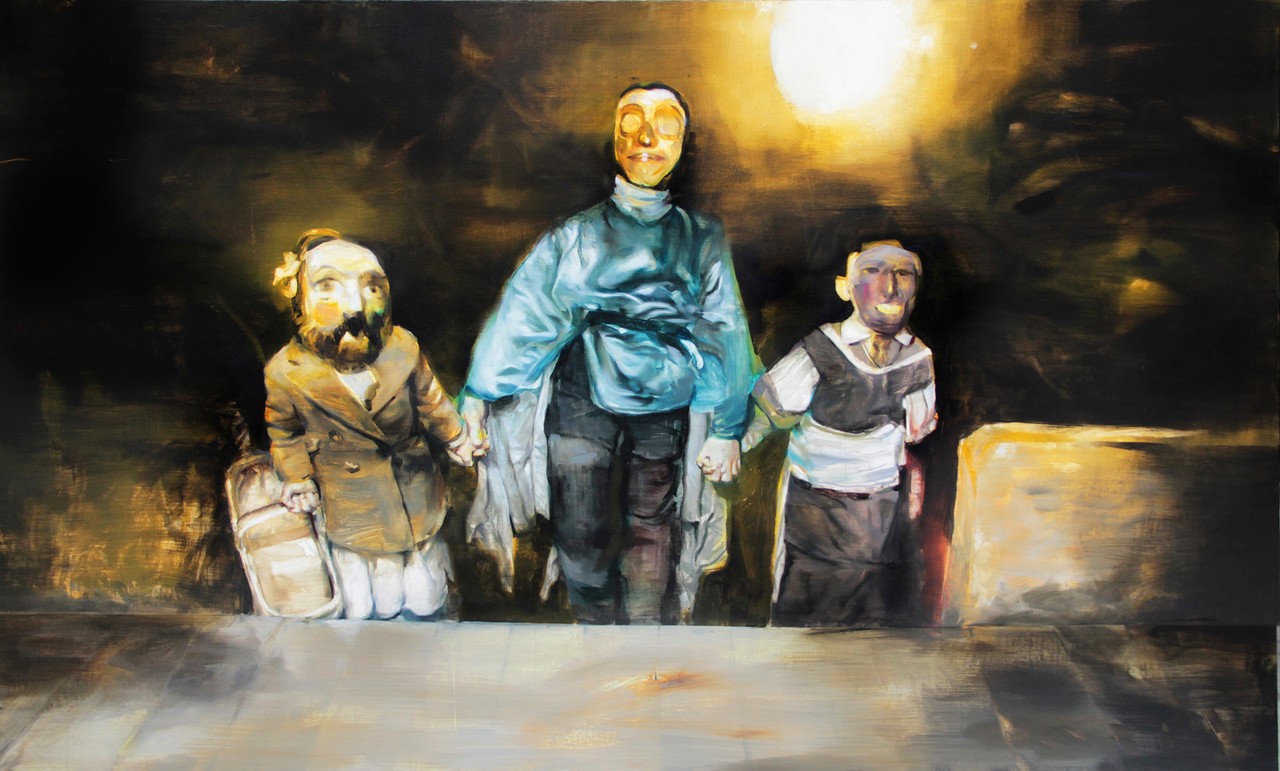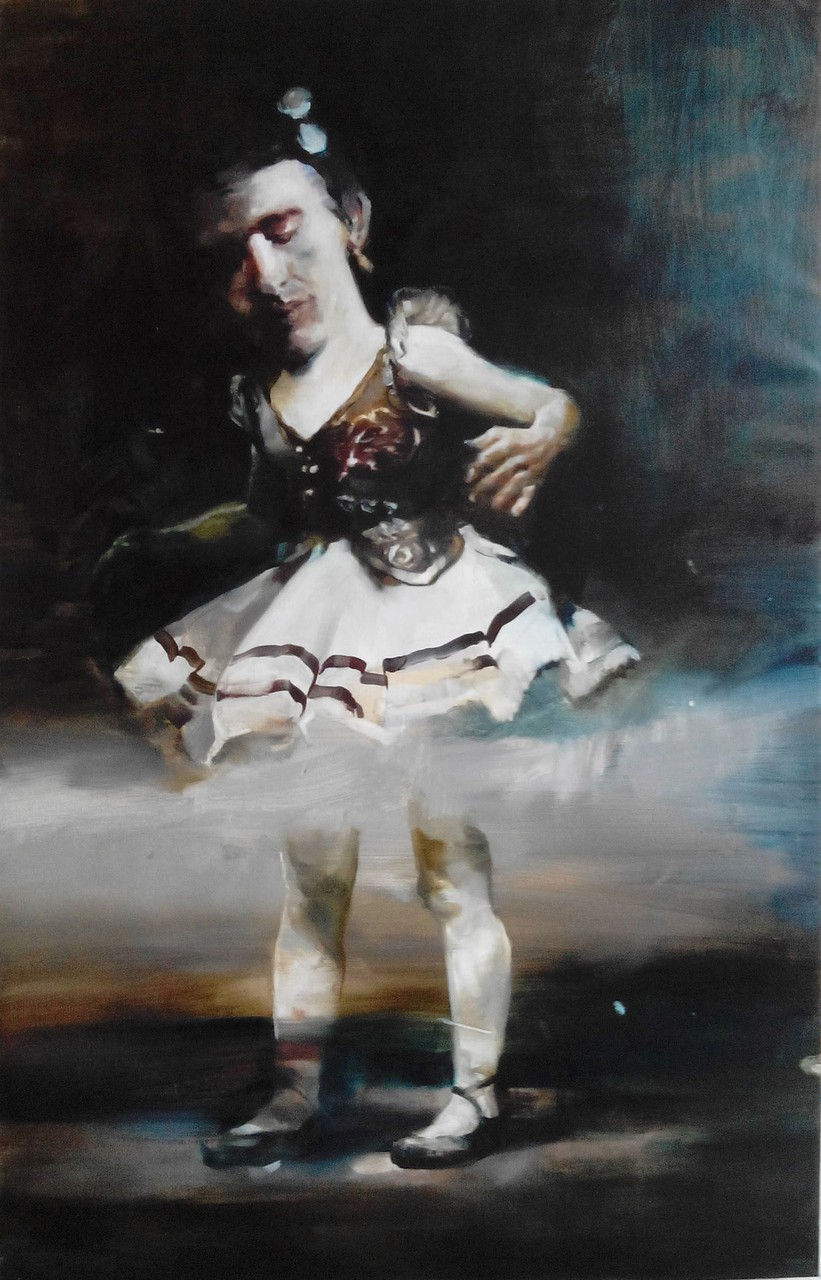François Jacob
23 Jun - 05 Aug 2017
Thomas Rehbein Gallery is pleased to announce the first solo exhibition with works by Belgian artist François Jacob. The paintings seem to revive the technique of old Dutch and Spanish masters while capturing oppressive settings in a manner resembling theatrical scenes, in which man – like a puppet – is trapped in a grotesque play with an indistinct and mysterious cast of characters.
François Jacob, who was born in Brussels in 1976, places his protagonists, which are often equipped with costumes and props, in a predominantly dark pictorial space, the background appearing inexistent or invisible. This confining lack of any spatial depth combines with the blue-green tonality to evoke a prevailing mood of melancholy. The rather unspectacular scene is performed by just one or two figures and carried out in the foreground, thus mimicking a stage action that is enhanced by a dramatic baroque lighting, emphasizing the division between an overwhelming brightness and a brooding duskiness. The action in question, however, seems suspended just like a movie still that has been removed from its narrative context and now appears replete with suspense and suggestive of a plot that remains a secret to the viewer.
Often the beam of a single spotlight starkly illuminates the characters: an actress who has discretely withdrawn behind the curtains for a costume change is roughly exposed by the glaring light. The fragile nature of nakedness, not of the flesh, but of the situation itself, becomes visible. Like a paparazzo snapshot, the gaze is directed behind the scenes, following the image hunter in his aim of capturing an off-guard moment (Actrice). Jacob’s manipulative use of effects of light and shadow seems to stem from an intense revelatory motivation, in which the representation and overt display of subjects in painting and art is questioned as well. Not only is the boundary between public and private space neutralised in this particular depiction, but the viewer also becomes engaged in a play with roles, forcing him to reflect on his own part as a spectator or even voyeur.
Jacob’s staging literally “brings something to light”: it reveals a different reality, introducing parallel worlds and providing a glance into the secret realms of the soul. In concentrating on situations related to disguising, camouflaging, the artist demonstrates the fundamental schism between true self and an assumed, artificial persona. The conflict between outer appearance and inner reality in particular serves to emphasize the ambiguity to which mankind acquiesces.
Consequently, expressing estrangement, the protagonists appear strange, such as the human figure clumsily kneeling on the wooden floor, its head replaced by a huge donkey ́s head with large ears – a monstrous prop (Canasson). The confrontation with a chimerical appearance is made even more tangible in a frontal view of three figures moving forwards side by side (Marches). Judging from their different heights and linked hands, we could be witnessing a mother with her two children. Their faces however, covered by masks, are unrecognisable and unidentifiable. A feeling of disconcertion arises as distinctive traits are blurred. In a heightened manner, this vexation is perceived when regarding the figure of a dancer, who is in equal parts woman, man and child. Sexual ambiguity is pervasive, replacing the concept of an essentially unified and closed subject with a multiplicity of personality styles as a result of splitting and projective identification.
As such, all of François Jacob ́s subjects embody a primordial estrangement, articulated through an introverted, misplaced demeanor. Seeming to hide behind a fictitious façade and often ridiculously distorted, they parade in front of the spectator like a line-up of court characters from a Diego Velázquez painting, consisting of sorrowful dwarves, slaves and jesters. François Jacob’s powerful works reflect the world as a stage, the masquerade of human being and they blatantly expose the ambiguity of an existence that manifests itself in “many faces”.
François Jacob, who was born in Brussels in 1976, places his protagonists, which are often equipped with costumes and props, in a predominantly dark pictorial space, the background appearing inexistent or invisible. This confining lack of any spatial depth combines with the blue-green tonality to evoke a prevailing mood of melancholy. The rather unspectacular scene is performed by just one or two figures and carried out in the foreground, thus mimicking a stage action that is enhanced by a dramatic baroque lighting, emphasizing the division between an overwhelming brightness and a brooding duskiness. The action in question, however, seems suspended just like a movie still that has been removed from its narrative context and now appears replete with suspense and suggestive of a plot that remains a secret to the viewer.
Often the beam of a single spotlight starkly illuminates the characters: an actress who has discretely withdrawn behind the curtains for a costume change is roughly exposed by the glaring light. The fragile nature of nakedness, not of the flesh, but of the situation itself, becomes visible. Like a paparazzo snapshot, the gaze is directed behind the scenes, following the image hunter in his aim of capturing an off-guard moment (Actrice). Jacob’s manipulative use of effects of light and shadow seems to stem from an intense revelatory motivation, in which the representation and overt display of subjects in painting and art is questioned as well. Not only is the boundary between public and private space neutralised in this particular depiction, but the viewer also becomes engaged in a play with roles, forcing him to reflect on his own part as a spectator or even voyeur.
Jacob’s staging literally “brings something to light”: it reveals a different reality, introducing parallel worlds and providing a glance into the secret realms of the soul. In concentrating on situations related to disguising, camouflaging, the artist demonstrates the fundamental schism between true self and an assumed, artificial persona. The conflict between outer appearance and inner reality in particular serves to emphasize the ambiguity to which mankind acquiesces.
Consequently, expressing estrangement, the protagonists appear strange, such as the human figure clumsily kneeling on the wooden floor, its head replaced by a huge donkey ́s head with large ears – a monstrous prop (Canasson). The confrontation with a chimerical appearance is made even more tangible in a frontal view of three figures moving forwards side by side (Marches). Judging from their different heights and linked hands, we could be witnessing a mother with her two children. Their faces however, covered by masks, are unrecognisable and unidentifiable. A feeling of disconcertion arises as distinctive traits are blurred. In a heightened manner, this vexation is perceived when regarding the figure of a dancer, who is in equal parts woman, man and child. Sexual ambiguity is pervasive, replacing the concept of an essentially unified and closed subject with a multiplicity of personality styles as a result of splitting and projective identification.
As such, all of François Jacob ́s subjects embody a primordial estrangement, articulated through an introverted, misplaced demeanor. Seeming to hide behind a fictitious façade and often ridiculously distorted, they parade in front of the spectator like a line-up of court characters from a Diego Velázquez painting, consisting of sorrowful dwarves, slaves and jesters. François Jacob’s powerful works reflect the world as a stage, the masquerade of human being and they blatantly expose the ambiguity of an existence that manifests itself in “many faces”.




